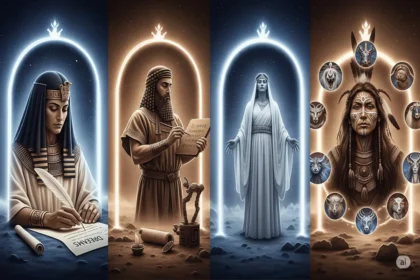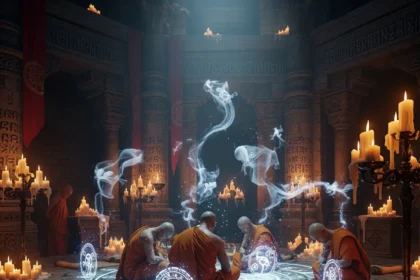In the heart of the Fertile Crescent, where the Tigris and Euphrates rivers cradled the dawn of civilization, the people of Ancient Mesopotamia looked to the night sky, and just as intently, to their nightly visions. For the Sumerians, Akkadians, Babylonians, and Assyrians, dreams were far more than mere figments of a sleeping mind; they were a vital, often terrifying, channel through which the gods communicated with mortals, offering glimpses into the future, issuing warnings, or even demanding specific actions. The interpretation of these nocturnal narratives was not a casual pastime but a sophisticated, sacred, and often perilous endeavor, deeply woven into the fabric of their daily lives, religious practices, and political decisions.
Imagine a Babylonian merchant, waking in a cold sweat from a dream of a crumbling wall. He wouldn’t simply shrug it off; he would seek guidance, fearing it portended financial ruin or a family illness. Or picture a king, troubled by a recurring vision of a dark bird, immediately summoning his baru (diviner) to decipher the divine message. For these ancient cultures, the dream world was not a separate, ethereal realm, but an active, influential extension of their reality, demanding careful attention and meticulous interpretation. Their surviving texts, etched in cuneiform on clay tablets, offer an extraordinary window into this profound spiritual landscape.
The Divine Messenger: Dreams as Communication from the Gods
At the core of Mesopotamian dream belief was the conviction that dreams were direct messages from the pantheon of gods and goddesses. Unlike modern psychological interpretations that focus on the dreamer’s subconscious, the Mesopotamians primarily viewed dreams as external communications. The gods, whether benevolent or wrathful, used dreams to convey their will, express their displeasure, or offer guidance.
The significance of a dream often depended on the deity believed to be sending it, or the context in which it appeared. A dream from the moon god Sin, for instance, might relate to fertility or the harvest, while a vision from the storm god Adad could portend destruction or a change in political fortunes. This belief system imbued dreams with immense power, making their accurate interpretation crucial for personal well-being and the stability of the state.

The Epic of Gilgamesh: A Literary Window into Dream Beliefs
One of the most compelling pieces of evidence for the importance of dreams in Mesopotamia comes from the Epic of Gilgamesh, humanity’s oldest surviving epic poem, dating back to at least the third millennium BCE. The epic is punctuated by several pivotal dream sequences that drive the narrative and reveal the characters’ fates.
Early in the epic, Gilgamesh, the mighty king of Uruk, has two significant dreams before the arrival of Enkidu, his wild-man companion. In one, a meteorite falls from the sky; in another, an axe appears in Uruk. Gilgamesh’s mother, the goddess Ninsun, acts as his dream interpreter. She explains that the meteorite and the axe both symbolize a powerful, wild man who will become Gilgamesh’s equal and companion. These interpretations prove accurate, demonstrating the predictive power attributed to dreams.
Later, as Gilgamesh and Enkidu embark on their perilous journey to the Cedar Forest to confront the monstrous Humbaba, Gilgamesh experiences a series of terrifying dreams. Enkidu, in turn, interprets these dreams for Gilgamesh, often twisting the ominous imagery into positive omens to bolster his friend’s courage. For example, a dream of a mountain falling on them is interpreted by Enkidu as a sign of their eventual triumph over Humbaba. This dynamic highlights not only the belief in dreams’ predictive power but also the psychological role of interpretation in managing fear and bolstering morale. The epic thus serves as a powerful literary testament to the cultural centrality of dreams.
The Professional Interpreter: Baru and the Dream Books
Given the profound significance of dreams, their interpretation was a highly specialized and respected profession. The baru, or diviner, was a skilled expert trained in the intricate art of deciphering divine messages, including those conveyed through dreams. These individuals were not mere fortune-tellers; they were learned scholars, often associated with temples or royal courts, who possessed extensive knowledge of omens, rituals, and the complex symbolic language of dreams.
The baru would consult elaborate “dream books” – collections of cuneiform tablets that served as comprehensive manuals for dream interpretation. The most famous of these is the Iškar Zaqīqu, or “The Series of the Dream-God Zaqīqu,” dating primarily from the Neo-Assyrian period (c. 9th-7th centuries BCE). This extensive compendium, often spanning multiple tablets, listed hundreds, if not thousands, of dream scenarios and their corresponding interpretations.
The structure of these dream books was typically formulaic: “If a man dreams he does X, then Y will happen.” For example:
The interpretations were often based on wordplay, associations, or established symbolic meanings within Mesopotamian cosmology and mythology. The baru would not only interpret the dream but also advise on appropriate rituals or actions to either secure a good omen’s promise or avert a bad omen’s threat.
Good Dreams vs. Bad Dreams: The Concept of “Evil Omens”
Mesopotamian dream interpretation was heavily binary: dreams were either “good” (favorable, portending positive outcomes) or “bad” (unfavorable, indicating impending misfortune or divine displeasure). The Iškar Zaqīqu meticulously categorized dreams this way.
Bad dreams, or “evil omens,” were particularly concerning. They were believed to be sent by malevolent demons or angry gods, and if left unaddressed, could lead to illness, death, financial ruin, or political disaster. When a bad dream occurred, the dreamer or the baru would engage in specific rituals known as namburbi (“loosening” or “undoing”). These rituals involved prayers, incantations, offerings, and symbolic actions designed to appease the gods, purify the dreamer, and nullify the negative effects of the dream. For example, a ritual might involve washing oneself with water that had flowed over certain stones, or burning an effigy representing the evil omen. The belief was that through these rituals, the fate revealed in the dream could be altered or averted.
Dreams and Ritual: Active Engagement with the Nightly Visions
The Mesopotamians didn’t just passively receive dreams; they actively engaged with them. This engagement extended to various aspects of their lives:
The Enduring Legacy: From Ancient Omens to Modern Psychology
While modern neuroscience and psychology offer vastly different explanations for dreams – viewing them as products of our own brains, involved in memory consolidation, emotional processing, and problem-solving (as explored in other articles) – the Mesopotamian approach highlights humanity’s enduring fascination with these nightly narratives. Their detailed dream books and sophisticated interpretive practices represent some of the earliest systematic attempts to understand the human mind and its connection to the unseen world.
The Mesopotamian emphasis on external, divine communication stands in stark contrast to later Freudian or Jungian theories, which delve into the subconscious desires and archetypes within the dreamer. Yet, the very act of meticulously recording and analyzing dreams, of seeking patterns and meanings, laid a foundational stone for later inquiries into the nature of consciousness and the human psyche.
Conclusion: Whispers from the Ancient Night
The world of Ancient Mesopotamia was a world where the veil between the waking and dreaming realms was thin, where the whispers of the gods could be heard in the quiet of the night. Their meticulous records of dreams and their interpretations offer us a profound insight into a civilization that lived in intimate dialogue with its nocturnal visions. For them, dreams were not random, but purposeful; not personal, but often communal; not merely experienced, but actively engaged with through ritual and interpretation.
Their legacy reminds us that long before brain scans and sleep labs, humanity instinctively understood that sleep was more than just a pause. It was a gateway, a source of wisdom, a canvas for divine messages, and a mirror reflecting the deepest concerns of a people striving to understand their place in a complex and often unpredictable world. The echoes of their ancient dreams continue to resonate, a testament to our timeless quest to decipher the mysteries that unfold when we close our eyes.
Disclaimer: The information provided in this article is for general informational purposes only and does not constitute medical advice. It is not a substitute for professional medical advice, diagnosis, or treatment. Always seek the advice of your physician or other qualified health provider with any questions you may have regarding a medical condition. Never disregard professional medical advice or delay in seeking it because of something you have read on this website.














